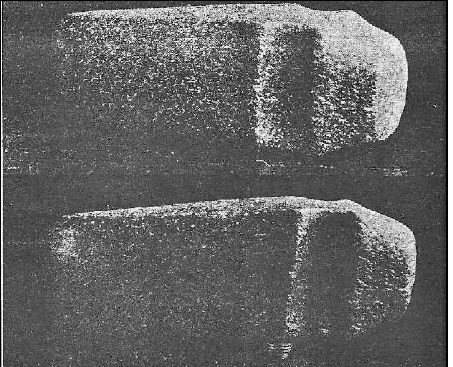|
A Bit of Iowa History
|
by Betty Roberts |
| Central States Archaeological Societies 2020
October Journal |
Mt. Sterling, Iowa |
| |
|
It was 50 years ago when a group of young energetic guys got together to
make Iowa the 7th state to join the Central States organization. They choose
the half-groove axe for the symbol on their society emblem. The following
article, written in 1920 by Charles Keyes, reflects on his early study and
findings on this type of axe. He pictures one found near Keosauqua, Iowa,
where the society held its first show in 1970. In 2020, the society will
celebrate its 50th Anniversary in the Roberts Memorial Building.
An Unusual Type of Grooved Stone Axe
|
by Charles R. Keyes |
| Central States Archaeological Societies 2020
October Journal |
Mount Vernon, Iowa
|
| November 15, 1920 |
|
|
This excerpt from "An Unusual Type of
Grooved Stone Axe" published in the 2020 Central States Archaeological Societies 2020
October Journal
Read the complete column in the Central States
Archaeological Societies 2020
October Journal which can be purchased on-line after March 2021
|
 |
Grooved stone axe found on the farm of Thomas E.
Dehart near Keosauqua, Iowa, 1880. Photo from the original article.
|
An Indian stone axe submitted to me for study and description by Curator
E.R. Harlan of the State Historical Department of Iowa is so unusual a specimen
that I believe it worthy of special notice. As the axe-maker’s art
reached a very high level of development in Iowa, it follows that any specimen
which can be called extraordinary here is to be counted among the best productions
of its kind known to American archaeology.
This particular axe was recently to the back, a device that would incline
the blade somewhat closer than the poll to the hand of the wielder and bring
the cutting edge into the most effective position for a slashing downward
blow. The poll is flattened and, being drawn in all around from the grooves
and front and back, is nearly elliptical in form. The front and the back
are straight and parallel, except near the top of the poll, and are slightly
hollowed, either to satisfy the taste of the maker or possibly to provide
for wedging in case the handle needed to be tightened.
It is not, however, the beauty, size and fine workmanship of this axe that
gives it chief claim to special recognition. Many other Iowa axes are equally
fine in material and workmanship. It is rather these qualities, combined
with its unusual form. Most grooved axes, wherever found, are either grooved “all-round” the
grooves entirely encircling the implement, or “threefourths” that
is, across both faces and across the front. This Van Buren County axe is
grooved across the two broad faces only, the front being flattened quite
like the back and showing no trace of a groove. It is, in short, the finest
specimen known to me of the rare “Keokuk type” stone axe, a type
first described by Fowke in 1896 on the basis of five specimens from near
Keokuk, Iowa, in the collections of the Smithsonian Institution. The original
reference is brief and is here quoted in full from the article entitled “Stone
Art,” by Gerard Fowke, Thirteenth Annual report of the Bureau of American
Ethnology for 1891-92 (published in 1896), page 68, under a classification
of grooved stone axes in the Smithsonian collection: “(Type) G. grooved
on faces only, with both sides flat (Figure 38, of granite from Keokuk, Iowa).
These are from the same place: one of porphyry, one of argillite, and three
of sienite. This and the preceding form (F) seem peculiar to that locality.”
Apparently these Keokuk-type axes have remained rare in ...
|
|




